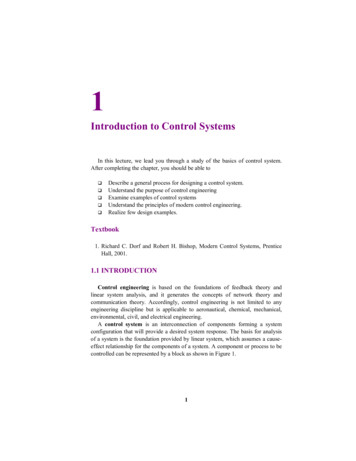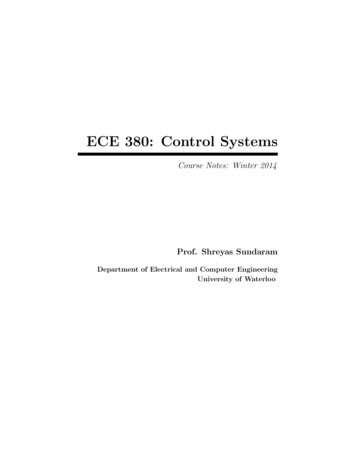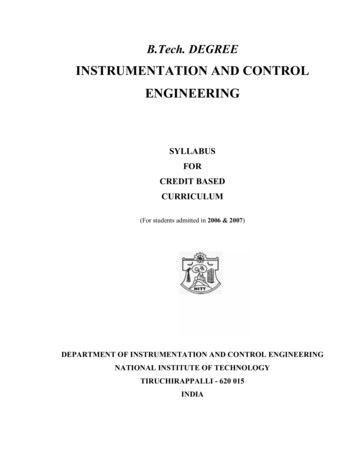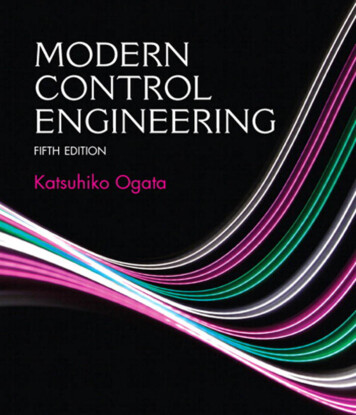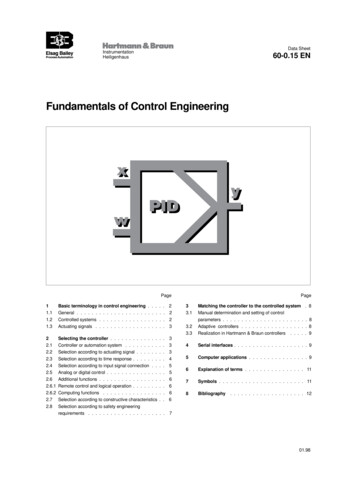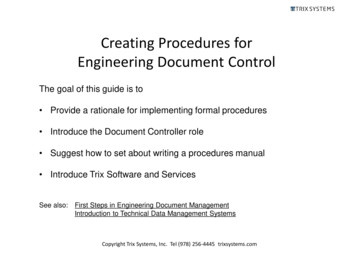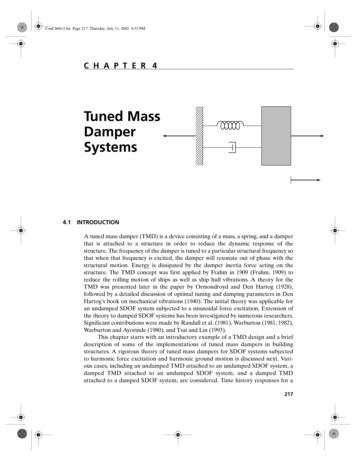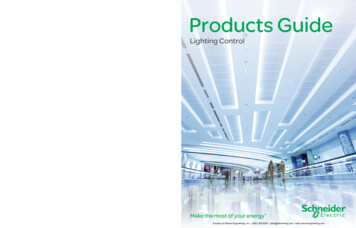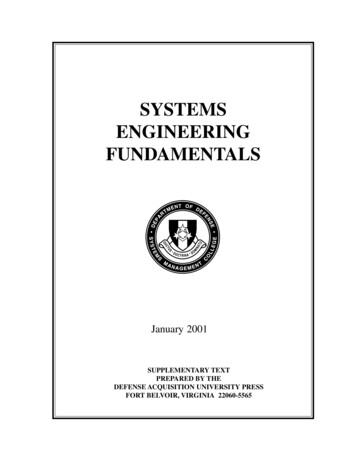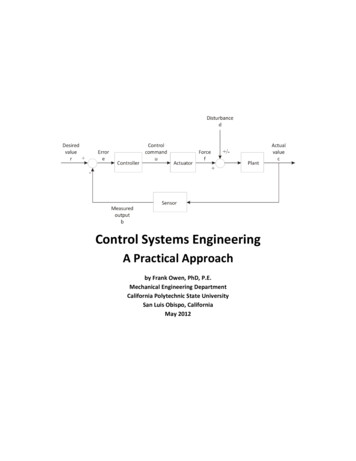
Transcription
Control Systems EngineeringA Practical Approachby Frank Owen, PhD, P.E.Mechanical Engineering DepartmentCalifornia Polytechnic State UniversitySan Luis Obispo, CaliforniaMay 2012
by Frank Owen, May 2012
Table of ContentsPrefaceAcknowledgementsChapter 1 – Introduction to control systemsChapter 2 – Laplace transformationsChapter 3 – System modelingChapter 4 – First‐ and second‐order system responseChapter 5 – StabilityChapter 6 – Steady‐state errorChapter 7 – Root locusChapter 8 – Frequency responseChapter 9 – Designing and tuning PID controllersChapter 10 – An introduction to digital control
PrefacePrefaceWhy this book?This book has been written for controls students at Cal Poly quite simply to save them money. There aremany, many good controls books available, but they have, in my opinion, three flaws.1) They are very expensive.2) They are rather reference books than a basic, first book—what one needs when first approachingthe subject. Thus we have found at Cal Poly that we buy a book for a lot of money and then use onlya small part of it. It is not that the parts that we don’t use don’t have any value. They do. But onedoesn’t need to buy a complete reference book to understand the basics and the essentials of atopic.3) They are highly mathematical. Controls is a very mathematical topic, perhaps the most heavilyladen mathematically in mechanical engineering. There are many good engineers in industry thatare not particularly adept at mathematics, who practice engineering with as much intuition andcommon sense as mathematical adeptness. A mathematical approach to controls loses sight of this,leaves many people behind, and does not take advantage of the fact that this topic also makes a lotof sense, a lot of common sense. Thus the approach taken here is to include what math is necessarybut to appeal to common sense and intuition whenever possible. With today’s modeling tools—read here Matlab/Simulink—a great deal of the math can be skipped and replaced with modelbuilding, to pose and answer questions that start with “What would happen if we ?”In addition it has always been my conjecture that what we have developed at Cal Poly in our controls labwould also be very useful to controls engineers in industry. Our lab, while not unique, is very rare. Itbrings controls down to earth and teaches controls engineers how to deal with real systems, how tomodel them and then tune the models, and how to set up and tune PID controllers for real systems.These are the essential skills that a controls engineer must have to operate in industry. In myexperience in academia, these essential skills are not often taught. Controls students have their headsfilled with mathematics, indeed the mathematics of complex numbers, but then they are not given evena starting notion of how such knowledge is applicable in the real world. This book focuses ever on thereal world of controls in industry. It tries never to lose sight of that goal and tries to avoid the alluringtrap of mathematical elegance and indeed mathematical snobbishness that seems common in the fieldof academic controls. So the book has also been written for industrial practitioners of control theorywho need to understand the topic and then bring into play to their advantage.The other influence that led me to write this book was the three years I spent teaching controls inGermany, two years at the Munich University of Applied Sciences and one year at the KarlsruheUniversity of Applied Sciences. In Germany textbooks are rare. Rather students work from a script, acollection of the professor’s notes organized and printed for student use. This book is really a script, acollection of my notes from teaching controls over the past decade. Though writing a book is a lot ofPreface‐1
Prefacework, it’s common practice to have short, directed scripts at low costs for poor students. So I thought,why don’t we do the same at Cal Poly? We have lots and lots of experience teaching controls, so weshould be able to come up with a good script. Besides, with our involvement in our laboratory, we havealready demonstrated that we can come up with a high‐quality document for teaching the lab portion ofthe course.Thus it is my hope that students will benefit from this practical approach to controls just as they areassuredly benefiting from saving almost 200 (in 2010). And I hope that this script serves as an exampleof what could be done in other courses at Cal Poly if professors would take their hard‐won experience,collect it, and make it available at low cost to those eager to learn but without a lot of money to buyexpensive reference books. This does not mean that one shouldn’t buy the expensive reference books.Maybe one needs them in his or her work. But at that stage, one has the means to buy them or one’scompany will buy them when there is a need.The use of Matlab/SimulinkIt is hard nowadays to envision practicing controls engineering without Matlab/Simulink. Theemployment of this software in analyzing systems and designing controllers—indeed now in runningreal controllers in physical systems—is de rigueur. This text does not include a tutorial in learningMatlab/Simulink. That’s available online or with the software. It is assumed that the reader has someknowledge of this software. Problems are posed in the text that directly direct the student to use thissoftware. Occasionally tips are given in specific applications that illustrate the utility of a particularMatlab command or Simulink procedure. If the user’s knowledge of this software is not at a level wherethese references to it make sense, he or she should explore the software a bit, researching its helpfacility for background knowledge. Controls requires knowing about only a tiny bit of Matlab andSimulink. So the reader is not required to do any extensive foundation‐building in order to be effectivewith Matlab/Simulink in his or her study of the subject.AcknowledgementsWow, how did a hillbilly guy from a lawyer family in Mississippi ever get to the point that he could sitdown and write a controls book almost directly out of his head? Well, if I told that whole story, that’dbe a book in itself. Lots of hard‐won experience but also lots of help along the way. It’s always been mycontention that when bestowing thanks, we never go far back enough. So I want to at least go back andthank my high school mathematics and physics teacher, Mac Egger. He didn’t plant the original seed,but he was there close to the beginning. Then there were lots of twists and turns to get to this point.Along the way: Glen Masada at the University of Texas at Austin taught me classical controls when Iwent and got a mid‐career PhD. Just before that I worked at one of the largest coal‐fired plants in theUnited States, American Electric Power’s Gavin plant in Gallipolis, Ohio. A plant engineer there taughtme a lot, Randy Scheidler. He taught me a lot about power plants but also about the level of knowledgeof good plant engineers in the United States. Randy served as a sort of model to use in keeping whatI’ve written practical, of trying never to write anything without showing how it is used. And I must back‐up further and thank the folks at Trax Corporation in Lynchburg, Virginia for their invitation to comePreface‐2
Prefacework for seven months with them in 1992 on power plant simulators. I learned lots about steam powerplants and how they’re controlled from this experience at Trax.Since my arrival at Cal Poly in 1998 I have been involved in controls as often as possible. The coursethere was handed off to me by Mike Ianci, Ed Garner, and Ed Baker. They had built a very practical,hands‐on lab. Though we’ve replaced much of the equipment in it, some is still left from those days,and much of what was added can be viewed as refinements and improvements of what theybequeathed to us. Here I have the pleasure of working with very practical, hand‐on people like myself—John Ridgely, Charles Birdsong, Bill Murray, and Xi Wu. All have contributed one way or another to ourwork in making this laboratory more practical and hands‐on. Some have had even to deal with theconsequences of what I regarded as a good idea at the time, that required a lot of work on their parts toimplement, to work the bugs out. Through their efforts we have a top‐notch controls lab. I have seen abetter one nowhere, neither in America nor in Europe. It was their sweat that made this lab the greatteaching tool that it has become.My two sojourns in Germany were important contributors to this book. I had the pleasure of workingwith several accomplished controls engineers there. Two stand out. Manfred Schuster at the MunichUniversity of Applied Sciences welcomed me into his lab and gave me a very concise script to teach outof. His script is, in fact, a model for mine. At the Karlsruhe University of Applied Sciences I had thepleasure of working with Helmut Scherf, a committed controls nerd. Helmut is a rare, rare example of apractical controls engineer. He has published a great book in German of Simulink models of verycommon, practical systems. He has built and is still building practical, low‐cost systems for his controlslab that serve as useful platforms for turning on the controls light in students’ heads. Many of hisperceptive, cut‐to‐the‐quick methods of thinking about controls topics have been incorporated into thisscript.So that’s the story in brief of how this book came about. I hope that you enjoy it and find it useful.Frank OwenSan Luis Obispo, California, U.S.A.May 2012Preface‐3
Chapter 1 – Introduction to Control SystemsChapter 1 – Introduction to Control SystemsGoalsThe purpose of this chapter is to give you an overview of the topic of control systems and to introduceyou to the basic concepts that you need to go forward. Presented are Basic control loop anatomy, the parts and pieces of control loops and how they are configuredPositioners vs. regulators, the two basic types of control loopsA fly‐by‐wire system vs. a cruise control system, iconic examples of the positioner and theregulatorA beginning discussion of block diagramsPID controllers, the most commonly used controllers in industryExamples of control systems used in industryControl theory is a relatively new field in engineering when compared with core topics, such as statics,dynamics, thermodynamics, etc. Early examples of control systems were developed actually before thescience was fully understood. For example the fly‐ball governor developed by James Watt to controloverspeed of his steam engine was developed out of necessity, long before the science of controls cameinto being. Figure 1.1 shows an example of this controller. The fly‐balls are mounted on a shaft thatturns and is driven by the engine through the pulley shown. As the engine speeds up, the fly‐balls areflung outward by their centrifugal force. This outward movement pulls the lever arm down, which raisesits other end. This is tied to the steam inlet valve, which closes as the flyball weights move furtheroutward. So if the engine tries to run away, the inlet steam valve will close, shutting off the fluid drivingthe engine.Figure 1.1 – Flyball governorMany say that the development of the airplane by the Wright brothers was enabled by theirunderstanding of controls‐‐that and the development of a light‐weight engine powerful enough to1‐1
Chapter 1 – Introduction to Control Systemspropel their machine into the air. Their development of wing warping enabled them to steer theirairplane, something that had been impossible up to that point. And it is certainly true that much ofcontrol theory grew up with the airplane, as airplanes were developed during the two world wars andalso throughout the 20th century for civilian purposes. As jet engines were developed and airplanesbecame bigger, it became ever more problematic to pilot an aircraft with just mechanical connectionsbetween the pilot’s controls in the cockpit and the surfaces elsewhere on the airplane that steer itthrough the air. Thus the fly‐by‐wire system was developed, which cut this direct connection betweenthe cockpit controls and the control surfaces on the airplane. In a fly‐by‐wire system, the movements ofthe stick or yoke and the rudder pedals in the cockpit are merely sensed by sensors. Electrical signalsare then sent to actuators driving the appropriate surfaces, and then these move the ailerons, theelevator, or the rudder to steer the plane according to the control inputs made by the pilot. Of coursethe force applied by the actuator on the control surface can be many times what a human could applydirectly. And the force can be applied at an actuator far distant from the pilot. So fly‐by‐wire bringswith it the advantage of force amplification and remote control.In industry one finds control systems of many types. In a refinery, chemical plant, food processing plant,or a power generation facility one finds control loops for controlling tank levels, pressures of fluids atvarious places in a plant, power output, valve position, pump, fan, or turbine speed. Modern‐day fighterjets actually are designed to be unstable. This allows them to maneuver quickly. They can only flybecause a control system stabilizes their flight, making corrections at a speed that no pilot could match.If one of these plane’s control system failed in flight, the plane would be unflyable and would crash.There has been a tremendous growth of control system use in the modern automobile. There are evennow drive‐by‐wire and brake‐by‐wire systems, where, like in the airplane, the direct mechanical orhydraulic connection between input devices and what they control has been cut and replaced by wish‐sensing devices and then transmission of an electrical signal to an actuator to turn the wheels or toapply the brakes. Like the control of the unstable airplane, skid detection and control take advantage ofan automatic control system’s speed. A driver who l
Control Systems Engineering . common, practical systems. He has built and is still building practical, low‐cost systems for his controls lab that serve as useful platforms for turning on the controls light in students’ heads. Many of his .
